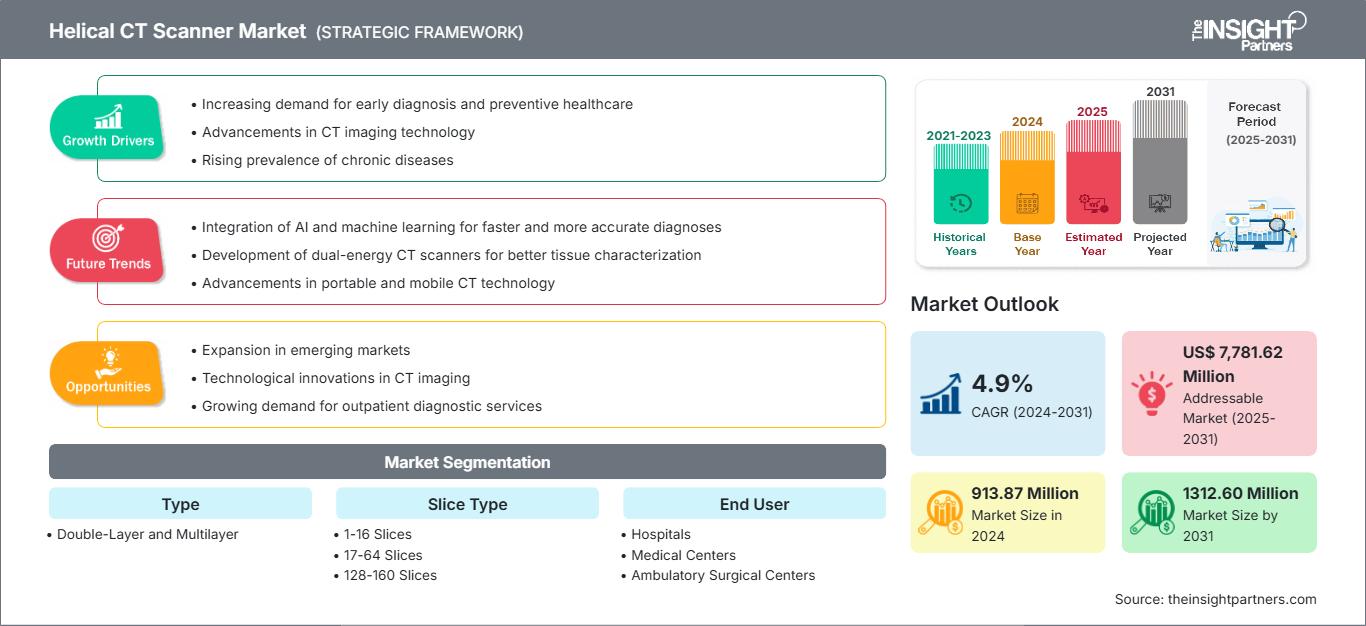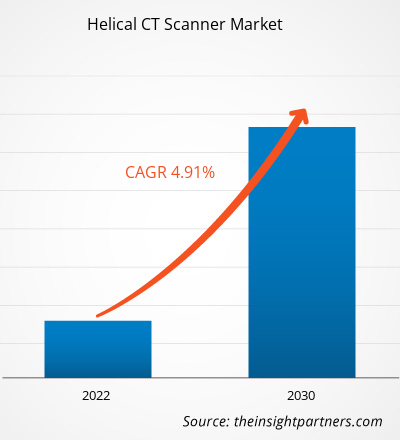나선형 CT 스캐너 시장 규모는 2024년 9억 1,387만 달러에서 2031년 13억 120만 달러로 성장할 것으로 예상됩니다. 이 시장은 2025년부터 2031년까지 5.28%의 CAGR을 기록할 것으로 예상됩니다.
나선형 CT 스캐너 시장 분석
나선형 CT 스캐너 시장의 성장은 암과 심혈관 질환과 같은 만성 질환의 발생률 증가, 기술 발전(예: 다중 슬라이스 영상, AI 통합), 신흥 시장에서의 의료 인프라 투자, 인구 고령화, 최소 침습 진단 및 조기 질병 발견에 대한 선호도에 의해 촉진되었습니다.
나선형 CT 스캐너 시장 개요
나선형 CT는 종양학, 심장학, 신경학, 응급 치료 및 외상 분야에서 빠르고 고해상도의 단면 영상을 제공하여 병원의 내과 및 외과, 진단 센터, 이동형 병동에서 이 시스템의 주요 사용자가 되고 있습니다. 인구 고령화, 만성 질환 유병률 증가, 신흥 경제국의 의료 인프라 확충, 그리고 다중 슬라이스 스캐너의 지속적인 혁신이 시장 확대의 주요 요인입니다. 북미 지역이 기술 도입을 선도하고 있지만, 아시아 태평양 지역이 가장 빠른 성장을 보이고 있습니다.
이 보고서의 일부 또는 국가 수준 분석, Excel 데이터 팩을 포함하여 모든 보고서에 대한 사용자 정의를 무료로 받을 수 있으며, 스타트업 및 대학을 위한 훌륭한 혜택과 할인도 이용할 수 있습니다.
나선형 CT 스캐너 시장: 전략적 통찰력

- 이 보고서의 주요 시장 동향을 알아보세요.이 무료 샘플에는 시장 동향부터 추정치 및 예측까지 다양한 데이터 분석이 포함됩니다.
나선형 CT 스캐너 시장 성장 요인 및 기회
시장 동인:
- 만성 질환의 유병률 증가: 암이나 심혈관 질환과 같은 만성 질환의 유병률이 높아짐에 따라 정확한 진단 도구의 사용이 필요해졌고, 이로 인해 나선형 CT 스캐너와 같은 장비에 대한 수요가 증가했습니다.
- 영상 기술의 발전: 스캔 시간 단축, 뛰어난 이미지 해상도, AI 통합 등의 새로운 기능으로 인해 병원과 실험실에서 나선형 CT 스캐너 사용이 꾸준히 늘고 있습니다.
- 노령 인구 증가: 노인은 노령과 관련된 건강 문제에 더 취약하므로 CT 스캐닝과 같은 진단 영상 방법이 질병 관리의 초기 단계에서 필수적이 되었습니다.
시장 기회:
- 휴대용 및 이동식 CT 스캐너 개발: 휴대용 및 이동식 CT 스캐너는 진료 현장에서 직접 의료 진단을 수행할 수 있도록 하여 원격지 및 응급 상황에서 중요한 이점을 제공합니다. 이 발명은 해당 제품에 대한 새로운 시장을 창출하고 접근성을 향상시켰습니다.
- 저선량 방사선과 환자 안전에 중점을 둡니다. 방사선으로 인한 피해를 줄이는 동시에 영상 품질을 개선하려는 노력은 성장을 위한 좋은 여지를 만들어냅니다. 의료에서 환자 안전이 가장 중요하기 때문입니다.
- 신흥 시장의 수요 증가: 개발도상국의 의료 인프라 확장과 의료 기술 지출 증가로 인해 나선형 CT 스캐너와 같은 진단 장비에 대한 수요가 증가하고 있습니다.
나선형 CT 스캐너 시장 보고서 세분화 분석
나선형 CT 스캐너 시장은 운영, 성장 잠재력, 그리고 현재 동향을 더욱 명확하게 이해하기 위해 여러 범주로 세분화되었습니다. 업계 보고서에 사용되는 표준 세분화 방식은 다음과 같습니다.
유형별:
- 이중층: 이중층 나선형 CT 스캐너는 두 세트의 데이터를 동시에 수집하여 더 나은 영상 선명도와 진단 정확도를 제공하기 때문에 인기가 높아지고 있습니다. 이러한 이중층 구조 덕분에 조직을 더 잘 구분할 수 있고, 대조도가 높아 심장과 암을 시각화하는 데 도움이 됩니다. 병원과 진단 센터에서 정확하고 빠르며 방사선량이 낮은 진단 도구에 대한 수요가 이중층 CT 기술의 전 세계적 확산의 주요 원인입니다.
- 다층: 한 회전으로 여러 개의 슬라이스를 촬영할 수 있는 다층 나선형 CT 스캐너는 스캔 시간을 단축하고 공간 해상도를 향상시키는 데 매우 유용합니다. 이러한 스캐너는 외상이나 빠르고 상세한 영상이 필요한 심장 검사에 사용할 수 있습니다. 의료 서비스 제공자들은 환자의 방사선 노출을 줄이면서 더 빠른 진단을 위해 노력하고 있으며, 이는 선진국과 신흥 시장에서 다층 CT 스캐너 수요를 견인하고 있습니다.
슬라이스 유형별:
- 1-16조각
- 17-64조각
- 128-160조각
- >160조각
최종 사용자별:
- 병원
- 의료 센터
- 외래 수술 센터
지리별:
- 북아메리카
- 유럽
- 아시아 태평양
- 남미 및 중미
- 중동 및 아프리카
나선형 CT 스캐너 시장 지역별 통찰력
The Insight Partners의 분석가들은 예측 기간 동안 헬리컬 CT 스캐너 시장에 영향을 미치는 지역별 동향과 요인을 면밀히 분석했습니다. 이 섹션에서는 북미, 유럽, 아시아 태평양, 중동 및 아프리카, 그리고 중남미 지역의 헬리컬 CT 스캐너 시장 부문 및 지역별 현황도 살펴봅니다.
나선형 CT 스캐너 시장 보고서 범위
| 보고서 속성 | 세부 |
|---|---|
| 2024년 시장 규모 | 9억 1,387만 달러 |
| 2031년까지 시장 규모 | 13억 120만 달러 |
| 글로벌 CAGR(2025~2031년) | 5.28% |
| 역사적 데이터 | 2021-2023 |
| 예측 기간 | 2025-2031 |
| 다루는 세그먼트 | 유형별
|
| 포함된 지역 및 국가 | 북아메리카
|
| 시장 선도 기업 및 주요 회사 프로필 |
|
나선형 CT 스캐너 시장 참여자 밀도: 비즈니스 역학에 미치는 영향 이해
나선형 CT 스캐너 시장은 소비자 선호도 변화, 기술 발전, 그리고 제품 이점에 대한 인식 제고 등의 요인으로 인한 최종 사용자 수요 증가에 힘입어 빠르게 성장하고 있습니다. 수요가 증가함에 따라 기업들은 제품 라인업을 확장하고, 소비자 니즈를 충족하기 위한 혁신을 추진하며, 새로운 트렌드를 적극 활용하고 있으며, 이는 시장 성장을 더욱 가속화하고 있습니다.

- 나선형 CT 스캐너 시장 주요 기업 개요를 확인하세요
지역별 나선형 CT 스캐너 시장 점유율 분석
아시아 태평양 지역은 향후 몇 년 동안 가장 빠른 성장을 보일 것으로 예상됩니다. 남미, 중동, 아프리카의 신흥 시장은 나선형 CT 스캐너 공급업체들이 성장할 수 있는 미개척 기회를 제공합니다.
나선형 CT 스캐너 시장의 성장은 의료 투자 증가, 의료 관광 증가, 만성 질환 증가, 기술 발전 등의 요인으로 인해 지역별로 차이가 있습니다. 아래는 지역별 시장 점유율 및 추세를 요약한 것입니다.
1. 북미
- 시장 점유율: 글로벌 시장의 상당 부분을 차지합니다.
- 주요 동인: 정교한 의료 시설, 많은 만성 질환, 잘 확립된 보상 시스템.
- 추세: AI 기반 영상, 초저선량 스캐닝, 병원 현대화, 구형 CT 장비 단계적 폐지.
2. 유럽
- 시장 점유율: 상당한 시장 점유율
- 주요 동인: 노인 인구 증가, 체계적인 공공 의료, 진단 도구 사용을 위한 지원 정책.
- 추세: EU 규제 요건(예: MDR)의 조화, 국경 없는 의료 서비스, 영상과 건강 플랫폼의 통합 디지털화.
3. 아시아 태평양
- 시장 점유율: 매년 시장 점유율이 증가하는 가장 빠르게 성장하는 지역
- 주요 동인: 의료비 지출 증가, 중국과 인도의 환자 인구 증가, 의료 영상 인프라의 급성장.
- 추세: 의료 관광 확대, 모바일/영상 홍보 프로그램, 차세대 CT 기술의 급속한 도입, 현지 생산.
4. 남미 및 중미
- 시장 점유율: 꾸준한 성장과 함께 성장하는 시장
- 주요 동인: 의료 접근성 확대, 진단 영상에 대한 수요 증가, 최신 CT 스캐너를 갖춘 병원 증가.
- 추세: 공공-민간 파트너십을 통한 진단의 현대화, 설치 기반의 전환, 신흥 시장으로의 지역 유통업체 확장.
5. 중동 및 아프리카
- 시장 점유율: 규모는 작지만 빠르게 성장하고 있습니다.
- 주요 동인: 의료 인프라에 대한 투자, 진단에 대한 인식, 영상 기술에 대한 정부 지원으로 인해 중동 및 아프리카 지역은 새로운 성장 잠재력을 보여줍니다.
- 추세: 접근하기 어려운 지역에 휴대용/이동식 나선형 CT 장치를 사용하고, 영상의학 센터의 역량을 강화하며, 값비싼 장비에 대한 임대 옵션을 활용합니다.
나선형 CT 스캐너 시장 참여자 밀도: 비즈니스 역학에 미치는 영향 이해
높은 시장 밀도와 경쟁
GE HealthCare Technologies Inc.와 Neusoft Medical Systems와 같은 기존 업체들의 존재로 인해 경쟁이 치열합니다. 지역 및 틈새 시장 공급업체들이 지역 간 경쟁을 더욱 심화시키고 있습니다.
경쟁 수준이 높기 때문에 기업은 다음과 같은 서비스를 제공하여 두각을 나타내야 합니다.
- 고급 제품
- 제품 승인
- 규제 지침 준수
기회와 전략적 움직임
- 전 세계 나선형 CT 스캐너 시장은 다양한 의료 분야에서 질병의 조기 진단과 더 나은 영상 품질에 대한 수요가 증가함에 따라 상당한 성장을 경험하고 있습니다.
- 선도적인 기업은 AI 통합에 자금을 투자하고, 신흥 시장에 진출하고, 협업을 형성하여 기술 수준과 시장에서의 입지를 모두 개선할 수 있습니다.
연구 과정에서 분석된 다른 회사:
- 히타치 메디컬 주식회사
- 시마즈 주식회사
- 케어스트림 헬스 주식회사
- 코닝 코퍼레이션
- Accuray Incorporated
- 에사오테 스파
- 아날로직 코퍼레이션.
나선형 CT 스캐너 시장 뉴스 및 최근 동향
- ASTRO 2025에서 필립스는 방사선 치료 분야의 최신 CT 및 MR 혁신 기술을 선보이며 정밀 암 치료에 전념합니다. 새로운 Rembra RT 및 Areta RT CT 플랫폼은 고급 워크플로우를 통해 방사선 치료의 정밀도와 생산성을 향상시키고 장기적인 가치를 제공합니다. 필립스는 AI 기반 SmartSpeed Precise를 탑재한 헬륨 프리 BlueSeal RT 1.5T 70cm MR 시스템을 선보이며 방사선 종양학 분야에서 MR 지속 가능성 리더십을 더욱 강화했습니다.
- 인도 최대 가전 브랜드인 삼성은 삼성전자 자회사인 뉴로로지카(NeuroLogica)와 협력하여 차세대 모바일 CT 제품 포트폴리오를 인도에 출시했습니다. 새롭게 출시된 제품군에는 세레톰 엘리트(CereTom Elite), 옴니톰 엘리트(OmniTom Elite), 옴니톰 엘리트 PCD(OmniTom Elite PCD), 바디톰 32/64(BodyTom 32/64)가 포함되며, 각 제품군은 병원 및 전문 센터의 임상적 요구 사항을 충족하도록 설계되었습니다.
나선형 CT 스캐너 시장 보고서 범위 및 제공물
"나선형 CT 스캐너 시장 규모 및 예측(2021~2031)" 보고서는 아래 영역을 포괄하여 시장에 대한 자세한 분석을 제공합니다.
- 범위에 포함된 모든 주요 시장 부문에 대한 글로벌, 지역 및 국가 수준의 나선형 CT 스캐너 시장 규모 및 예측
- 나선형 CT 스캐너 시장 동향 및 동인, 제약 및 주요 기회와 같은 시장 역학
- 자세한 PEST 및 SWOT 분석
- 주요 시장 동향, 글로벌 및 지역 프레임워크, 주요 참여자, 규정 및 최근 시장 개발을 다루는 나선형 CT 스캐너 시장 분석
- 시장 집중도, 히트맵 분석, 주요 업체 및 나선형 CT 스캐너 시장의 최근 개발 사항을 다루는 산업 환경 및 경쟁 분석
- 자세한 회사 프로필
- 과거 분석(2년), 기준 연도, CAGR을 포함한 예측(7년)
- PEST 및 SWOT 분석
- 시장 규모 가치/거래량 - 글로벌, 지역, 국가
- 산업 및 경쟁 환경
- Excel 데이터세트
최근 보고서
관련 보고서
사용 후기
구매 이유
- 정보에 기반한 의사 결정
- 시장 역학 이해
- 경쟁 분석
- 고객 인사이트
- 시장 예측
- 위험 완화
- 전략 기획
- 투자 타당성 분석
- 신흥 시장 파악
- 마케팅 전략 강화
- 운영 효율성 향상
- 규제 동향에 발맞춰 대응




















 무료 샘플 받기 - 나선형 CT 스캐너 시장
무료 샘플 받기 - 나선형 CT 스캐너 시장